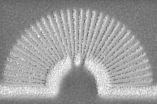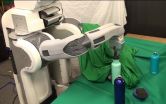(Press-News.org) MANHATTAN , Kansas -- A recent study with Kansas State University researchers details vaccine development for two new strains of avian influenza that can be transmitted from poultry to humans. The strains have led to the culling of millions of commercial chickens and turkeys as well as the death of hundreds of people.
The new vaccine development method is expected to help researchers make vaccines for emerging strains of avian influenza more quickly. This could reduce the number and intensity of large-scale outbreaks at poultry farms as well as curb human transmission.
It also may lead to new influenza vaccines for pigs, and novel vaccines for sheep and other livestock, said Jürgen Richt, Regents distinguished professor of veterinary medicine and director of the U.S. Department of Homeland Security's Center of Excellence for Emerging and Zoonotic Animal Diseases.
Richt and his colleagues focused on the avian influenza virus subtype H5N1, a new strain most active in Indonesia, Egypt and other Southeast Asian and North African countries. H5N1 also has been documented in wild birds in the U.S., though in fewer numbers.
"H5N1 is a zoonotic pathogen, which means that it is transmitted from chickens to humans," Richt said. "So far it has infected more than 700 people worldwide and has killed about 60 percent of them. Unfortunately, it has a pretty high mortality rate."
Researchers developed a vaccine for H5N1 by combining two viruses. A vaccine strain of the Newcastle disease virus, a virus that naturally affects poultry, was cloned and a small section of the H5N1 virus was transplanted into the Newcastle disease virus vaccine, creating a recombinant virus.
Tests showed that the new recombinant virus vaccinated chickens against both Newcastle disease virus and H5N1.
Researchers also looked at the avian flu subtype H7N9, an emerging zoonotic strain that has been circulating in China since 2013. China has reported about 650 cases in humans and Canada has reported two cases in people returning from China. About 230 people have died from H7N9.
"In Southeast Asia there are a lot of markets that sell live birds that people can buy and prepare at home," Richt said. "In contrast to the H5N1 virus that kills the majority of chickens in three to five days, chickens infected with the H7N9 virus do not show clinical signs of sickness. That means you could buy a bird that looks perfectly healthy but could be infected. If an infected bird is prepared for consumption, there is a high chance you could get sick, and about 1 in 3 infected people die."
Using the same method for developing the H5N1 vaccine, researchers inserted a small section of the H7N9 virus into the Newcastle disease virus vaccine. Chickens given this recombinant vaccine were protected against the Newcastle disease virus and H7N9.
"We believe this Newcastle disease virus concept works very well for poultry because you kill two birds with one stone, metaphorically speaking," Richt said. "You use only one vector to vaccinate and protect against a selected virus strain of avian influenza."
Using the Newcastle disease virus for vaccine development may extend beyond poultry to pigs, cattle and sheep, Richt said.
Researchers found they were able to protect pigs against an H3 influenza strain by using the Newcastle disease virus to develop a recombinant virus vaccine. Wenjun Ma, Kansas State University assistant professor of diagnostic medicine and pathobiology, is building on this finding and using the Newcastle disease virus to make a vaccine for porcine epidemic diarrhea virus, a disease that has killed an estimated 6 million pigs.
Richt conducted the avian influenza study with Ma, Adolfo Garcia-Sastre at the Icahn School of Medicine at Mount Sinai in New York, and several other colleagues. They published their findings in the Journal of Virology study, "Newcastle disease virus-vectored H7 and H5 live vaccines protect chickens from challenge with H7N9 or H5N1 avian influenza viruses." It is the first study to look at an H7N9 vaccine in chickens, the animals the disease originates in.
INFORMATION:
New research by scientists at the University of Maryland School of Medicine has found that esophageal cancer patients treated with proton therapy experienced significantly less toxic side effects than patients treated with older radiation therapies.
Working with colleagues at the Mayo Clinic in Rochester, Minnesota and the MD Anderson Cancer Center in Dallas, Texas, Michael Chuong, MD, an assistant professor of radiation oncology at the school, compared two kinds of X-ray radiation with proton therapy, an innovative, precise approach that targets tumors while minimizing ...
May 22, 2015 - Boston, MA - Few professions in the world benefit from the sharing of information as much as meteorology. Nearly all countries around the world realize the value of sharing meteorological data across their borders. This information collaboration is vital to scientific understanding of the atmosphere and the oceans, as well as essential for accurate forecasts and timely warnings of hurricanes, typhoons, and other severe weather.
But what about when one country maintains an active embargo with another country?
That question was answered last year, when ...
BUFFALO, N.Y. -- It looks like a Slinky suspended in motion.
Yet this photonics advancement -- called a metamaterial hyperlens -- doesn't climb down stairs.
Instead, it improves our ability to see tiny objects.
Described in a research paper published today by the journal Nature Communications, the hyperlens may someday help detect some of the most lethal forms of cancer.
It could also lead to advancements in nanoelectronic manufacturing and boost scientists' ability to examine single molecules -- a development with implications in physics, chemistry, biology and other ...
WASHINGTON, D.C. -- Disaster investigators and emergency personnel may find themselves better able to assess and respond to terrorist attacks and industrial accidents with the aid of a new computational tool that determines the energy from explosions near the Earth's surface. As a first test of the new approach, its developers have analyzed a deadly explosion which reportedly killed dozens of regime soldiers in the Syrian civil war.
Computing the energy yield of an explosion just below, at, or above the ground poses difficult challenges, while deep-underground blasts ...
New York, NY -- May 22, 2015 -- Working with researchers at Zhejiang University in China, Changxi Zheng, assistant professor of computer science at Columbia Engineering, has developed a technique that enables hydrographic printing, a widely used industrial method for transferring color inks on a thin film to the surface of manufactured 3D objects, to color these surfaces with the most precise alignment ever attained. Using a new computational method they developed to simulate the printing process, Zheng and his team have designed a model that predicts color film distortion ...
(NEW YORK - May 22) - By comparing flu viruses to the virus that causes measles, researchers fine-tuned a tool that may enable faster vaccine design, according to a study led by Mount Sinai researchers and published online this week in the journal Cell Reports.
The study results revolve around viruses, which are designed perfectly by evolution to invade human cells, inject viral genes and use human genetic machinery to make copies of them. In an endless back and forth, human immune cells have evolved to recognize and attack viral surface proteins, and viruses to constantly ...
(PARIS, FRANCE) Technique, talk, and talent were three buzzwords at the 2015 EuroPCR congress. As in years past, the conference featured a mix of breaking news, live case demonstrations, oral and poster sessions, debates, and tips-and-tricks tutorials. New study data have been increasingly showcased at EuroPCR and this year's meeting featured over 70 new abstract sessions throughout the four-day meeting, across five interventional tracks.
One of the focus topics at this year's meeting was a spate of recent trials showing a benefit for mechanical thrombectomy in acute ...
URBANA, Ill. - The widespread evolution of herbicide-resistant weeds is costing farmers, especially through decreases in productivity and profitability. Although researchers and industry personnel have made recommendations to slow this evolution, an understanding of the patterns and causes of the resistance has been limited.
Diversifying the herbicide mechanisms of action (MOAs) has been recommended to stop the spread of herbicide-resistant weeds. MOAs refer to the biochemical interaction that affects or disrupts the target site in the weed. Two common methods of diversifying ...
The first definitive summary of the best and safest blood pressure lowering treatments for kidney disease and diabetes patients has been compiled by New Zealand doctor and researcher Associate Professor Suetonia Palmer.
The international relevance of her work for doctors, patients and those who decide which drugs to fund has been demonstrated by the prestigious Lancet medical journal publishing an article on her study in its latest edition.
The University of Otago, Christchurch, researcher together with a global team used innovative statistical analysis to compare hundreds ...
Berkeley -- Researchers at the University of California, Berkeley, have developed algorithms that enable robots to learn motor tasks through trial and error using a process that more closely approximates the way humans learn, marking a major milestone in the field of artificial intelligence.
They demonstrated their technique, a type of reinforcement learning, by having a robot complete various tasks -- putting a clothes hanger on a rack, assembling a toy plane, screwing a cap on a water bottle, and more -- without pre-programmed details about its surroundings.
"What ...


